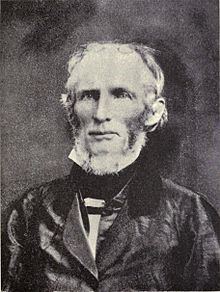Known for Missionary
Educator Education Dickinson College Role Hawaii | Name Richard Armstrong Religion Presbyterian Children Samuel C. Armstrong | |
 | ||
Born April 13, 1805 ( 1805-04-13 ) McEwensville, Pennsylvania Alma mater Dickinson College
Princeton Theological Seminary Spouse(s) Clarissa Chapman Armstrong (1805–1891) Died 1860, Honolulu, Hawaii, United States Resting place Kawaiahao Church and Mission Houses | ||
Richard Armstrong (April 13, 1805 – September 23, 1860) was a missionary from Pennsylvania who arrived in Hawaii in 1832. Along with his wife Clarissa, he served in mission fields of the Marquesas Islands and in the Kingdom of Hawaii. He established several churches and schools, and was Kahu (shepherd) of Kawaiahaʻo Church after the departure of Hiram Bingham I. Kamehameha III appointed him Minister of Public Instruction, and his accomplishments established an educational system that earned him the nickname "The father of American education in Hawaii".
Contents
- Background
- Nuku Hiva and Hawaii
- The father of American education in Hawaii
- Personal life and death
- References
Background
Richard Armstrong was born in Northumberland County, Pennsylvania on April 13, 1805, to James Armstrong and his American-born wife Eleanor Pollock. The elder Armstrong had been born in Enniskillen, County Fermanagh, Northern Ireland, and in 1786 emigrated to the United States, where he married Eleanor. The family were Presbyterian. Richard was the youngest child of the union. He was educated at Milton Academy in Massachusetts, furthering his education at Dickinson College in Pennsylvania, and graduating from Princeton Theological Seminary in 1831.
Nuku Hiva and Hawaii
Princeton president Archibald Alexander provided a letter of recommendation In 1831, when Armstrong made the decision to join the next contingent of missionaries being sent to Hawaii by the American Board of Commissioners for Foreign Missions. He received his ordination on October 27, and Armstrong and his new bride Clarissa departed with the other missionaries aboard the Averick on November 26. The ship docked in Honolulu on May 17, 1832, with Clarissa seven months pregnant. Daughter and first child Caroline Porter was born in Honolulu on July 17.
The board sent the Armstrongs to minister to cannibalistic tribes on Nuku Hiva in the Marquesas Islands July 2, 1833 through May 12, 1834, serving alongside missionary couples the Rev. William Patterson Alexander and his wife Mary, and the Rev. Benjamin Wyman Parker and his wife Mary Elizabeth. The first Armstrong son William Nevins was born on Nuku Hiva on January 2, 1834. The Nuku Hiva mission field was abandoned as futile.
The Armstrongs were reassigned to the Island of Maui, where the infant William Nevins died March 17, 1835 in Lahaina. Their second son had been born two days before on March 15, and he was given the name of his brother William Nevins. In July of that year, the Armstrongs were assigned to Wailuku. Three more children were born during this assignment. Mary Jane was born June 2, 1836 in Honolulu. Two sons were born in Wailuku, Richard Baxter on August 15, 1837, and Samuel Chapman on January 30, 1839. During his assignment on Maui, Armstrong established churches at Waihee, Wailuku, Ulupalakua, and at Haiku, where he also became an 1858 founder of Haiku Sugar Company on land he owned.
In 1840, Armstrong was appointed Kahu (shepherd) of Kawaiahaʻo Church to replace Hiram Bingham I. On August 26, 1854, he was licensed to perform marriages in Hawaii. Armstrong officiated at the June 19, 1856 wedding of Emma Rooke and Alexander Liholiho in Kawaiahaʻo Church. Additionally, Armstrong served on the government Privy council and the House of Nobles.
The father of American education in Hawaii
Under Kamehameha III, the position of Minister of Public Instruction of the Kingdom of Hawaii was created. On April 3, 1846, William Richards was appointed to fill the new position. When Richards died in 1847, Armstrong was appointed to fill the position. Armstrong held the position until 1855, when he became President of the Board of Education. The educational model he established in the kingdom earned Armstrong the sobriquet "The father of American education in Hawaii". He created a structured environment that was financially supported by a school tax. With Armstrong at the helm, curriculum was standardized, and the responsibilities of faith-based citizenship became a part of it. The kingdom's teachers were given extended training. Land grants were implemented for additional and improved facilities, and the kingdom began issuing its own textbooks. The public school system accommodated the majority of the students, but Armstrong also chartered private educational institutions.
Personal life and death
Richard Armstrong died September 23, 1860 following a riding accident which punctured an artery in his neck. He was buried on the grounds of Kawaiahaʻo Church.
He married Clarissa Chapman of Russell, Massachusetts. on September 5, 1831 in Bridgeport, Connecticut. She died July 20, 1891 in San Francisco, California.
